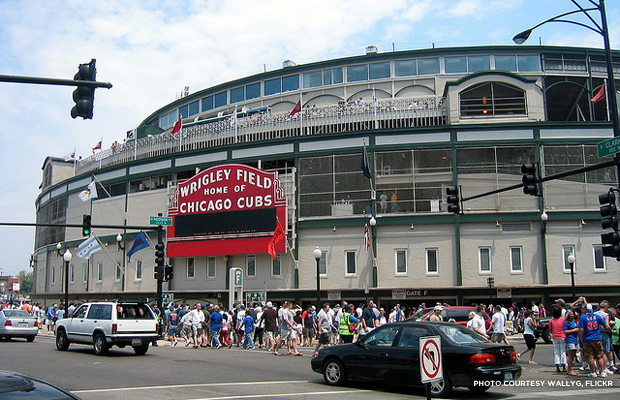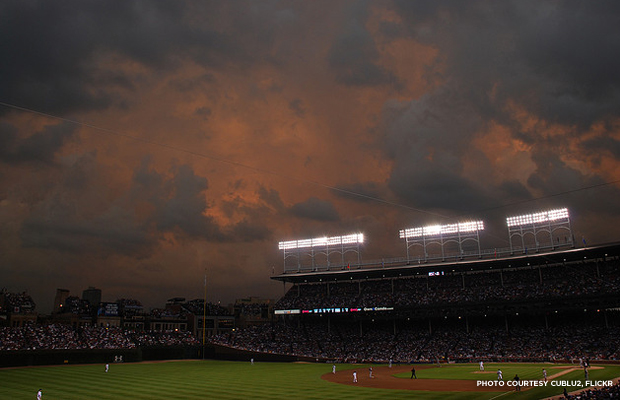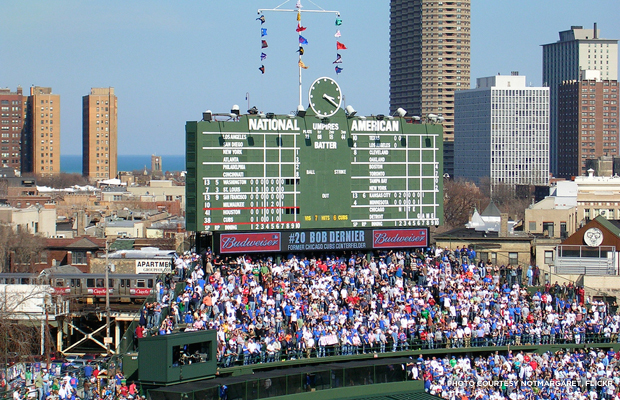
Historic Wrigley Field. Astute Cubs fans can gauge the point in the Major League season by the growth of ivy on the field's outfield walls.
Wrigley Field was originally built as Weeghman Park in 1914 for the Chicago Federals baseball team. In 1916, the Cubs moved in, and in 1926, it was renamed Wrigley Field after William Wrigley Jr., who bought out the shares of the team's other owners before the 1920 season.
Since then, the ballpark -- now the second-oldest venue in the Majors after Boston's Fenway Park -- has seen its share of history. Babe Ruth's called shot in the 1936 World Series and Ernie Banks' 500th career home run in 1970 both happened here. The stadium is also home to the Curse of the Billy Goat (it's best just to Google it) and the Steve Bartman incident during the 2003 National League Championship Series. (One thing Wrigley Field has never seen is a World Series championship).
But beginning in 2009, preservationists and baseball fans alike began to worry if some of the ballpark's historic fabric -- and perhaps some of the history that went along with it -- might be lost.

Wrigley Field has been home to the Chicago Cubs since 1916.
That's when the current owners, the Rickets family, purchased the Cubs and the ballpark from the Tribune Company, and began pushing for massive renovations of the historic stadium.
"They've been wanting to make improvements to the facility and to have opportunities for advertising as a revenue source," says Chris Morris, a senior field officer at the National Trust's Chicago Field Office.
By nearly all accounts, the desire for renovations is legitimate. Compared to other Major League venues, Wrigley is lacking in amenities for both players and patrons. There is a need for batting tunnels for indoor practice, and the locker rooms for both home and away teams are minimal. Restrooms for fans are nearly always overcrowded, and the stadium lacks space to actually cook food, limiting the options for concessions. There's also the issue of deferred maintenance on the stadium's structure itself.
"If you are in the stadium, particularly the lower deck seating, and you look up, it's a poured concrete structure like a lot of these places were, and you'll see netting all over the underside of the upper deck because the concrete is falling," says Morris.
As for the need for more advertising revenue, well, it wouldn't be America's pastime without unbridled capitalism.

In what was a major political and historical battle at the time, the Cubs play their first night game under newly installed lights at Wrigley in August of 1988. As part of tradition, the Cubs still play a large portion of their home games during the day.
Though the park's most iconic features like its ivy covered brick wall, outfield bleachers, and manually operated center field scoreboard were never in real danger, many still worried about the park's historic feel and ambiance.
"It's only within the last six months or so that they've really gotten to that point where there are real designs that people can evaluate and that people can present," says Morris, adding, "I think the preservation groups' biggest concern was what kind of signage they were going to be putting up in the outfield. And this LED scoreboard that they're talking about, how big is it going to be? What is it going to look like?"
According to those designs, the stadium's new scoreboard in left field is going to be just slightly smaller than its historic one in center field, theoretically making it deferential to its historic counterpart. The team is also planning a restoration of the stadium's historic exterior, with the intent to bring it back to its 1930s-era appearance to the greatest extent possible. And though there are also plans to create an additional entrance to the ballpark, there have been significant efforts to make sure that it is done tastefully.
"The first iteration we saw of [the new entrance] was very historic looking, so you would have had a very hard time telling that that wasn't something that was original," says Morris. "They've now changed that because it's not a historic feature. It'll be complimentary but definitely distinct from the fabric of the building so it's not like you're tricking anyone into thinking that that's an old piece of the stadium. I think those are the things that they're doing in response to the preservation community."

Wrigley's historic center field scoreboard will remain intact.
The Cubs are working with renowned preservation architect T. Gunny Harboe, AIA, who has worked on other premier preservation projects in the city like the restoration of Crown Hall and the Sullivan Center. The Cubs also plan to apply for preservation tax credits for all of the renovation work that goes towards restoring the ballpark's historic elements and their overall plans were recently approved by the Commission on Chicago Landmarks.
"They are taking all of the right steps," says Morris, "working with all of the right people, using all of the right tools, to turn this into what we consider to be an appropriate rehabilitation project."
If all goes to plan, it seems the only history Cubs fans will have to worry about is when their team will finally win a World Series at Wrigley Field.
